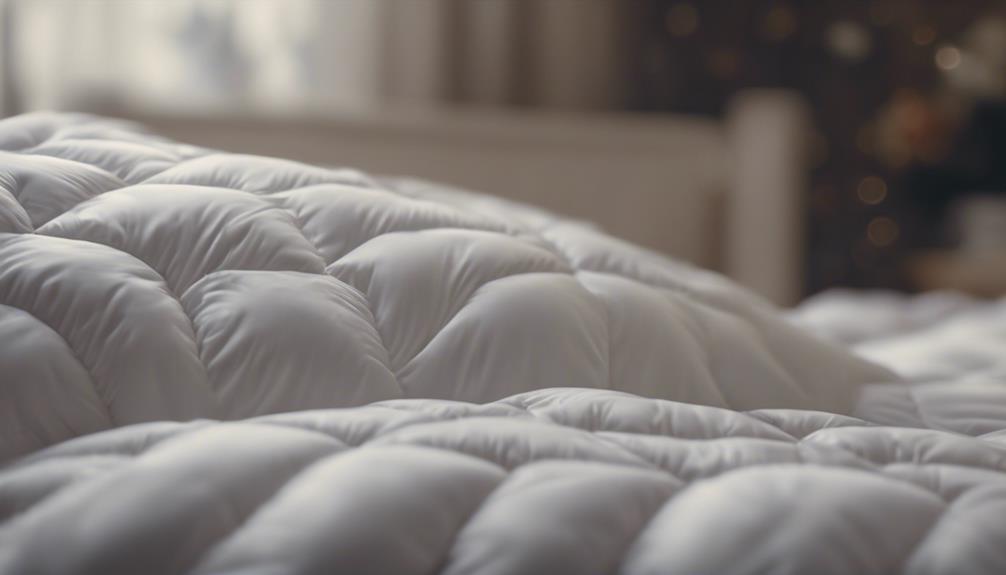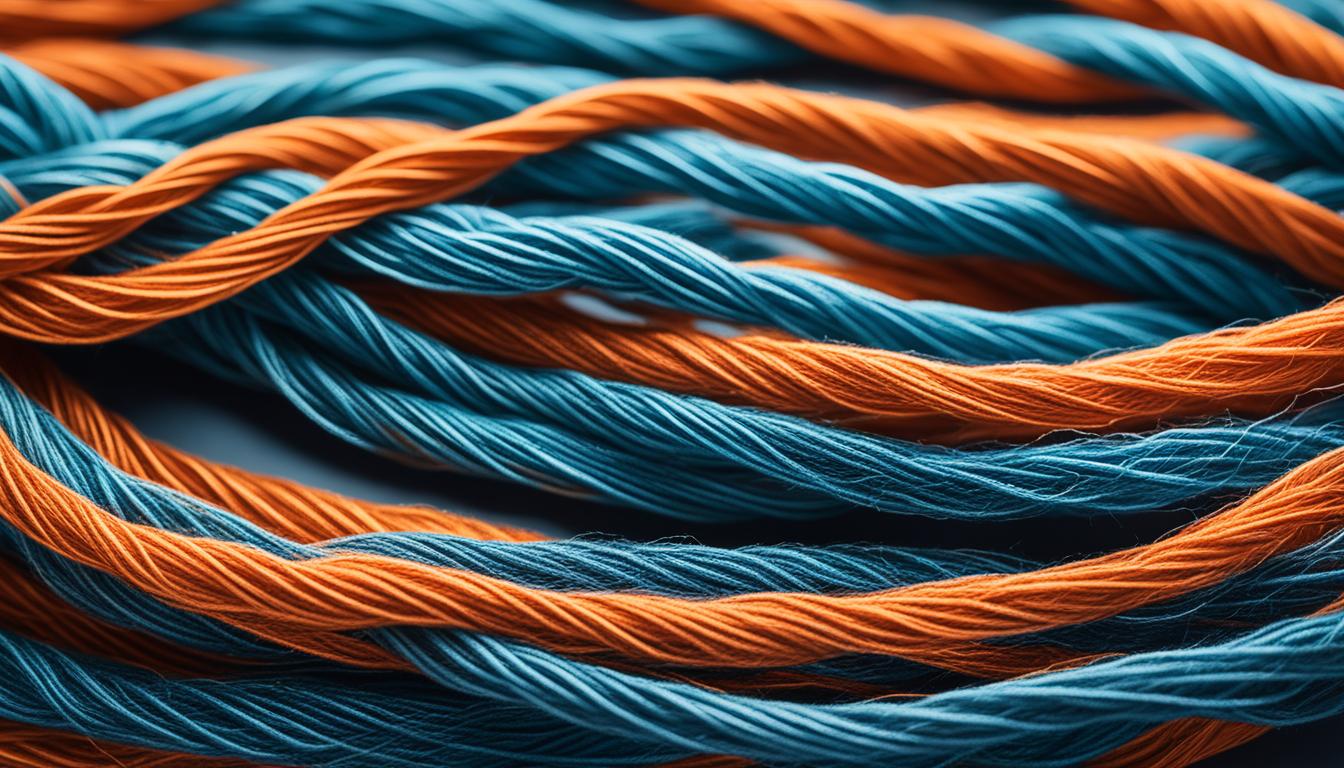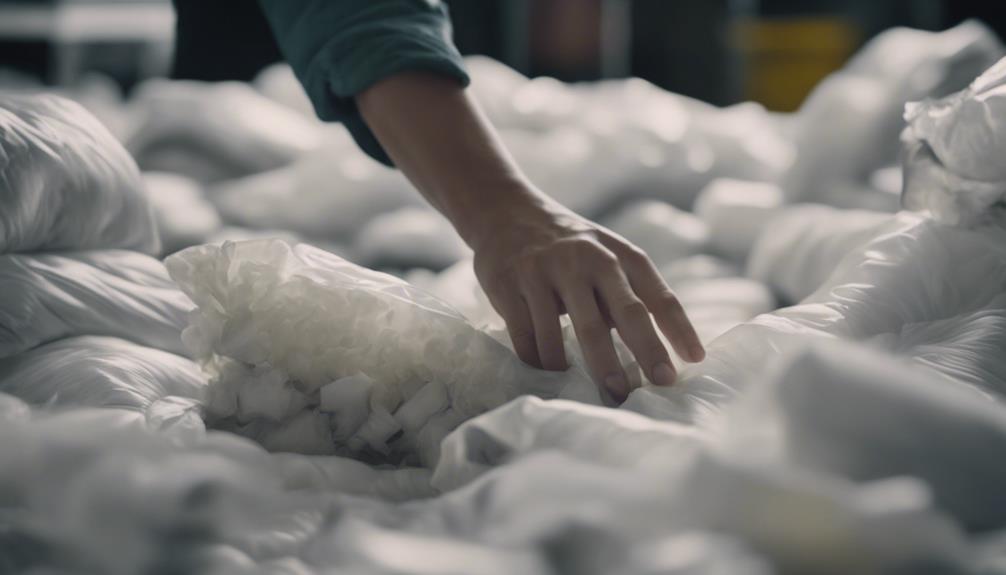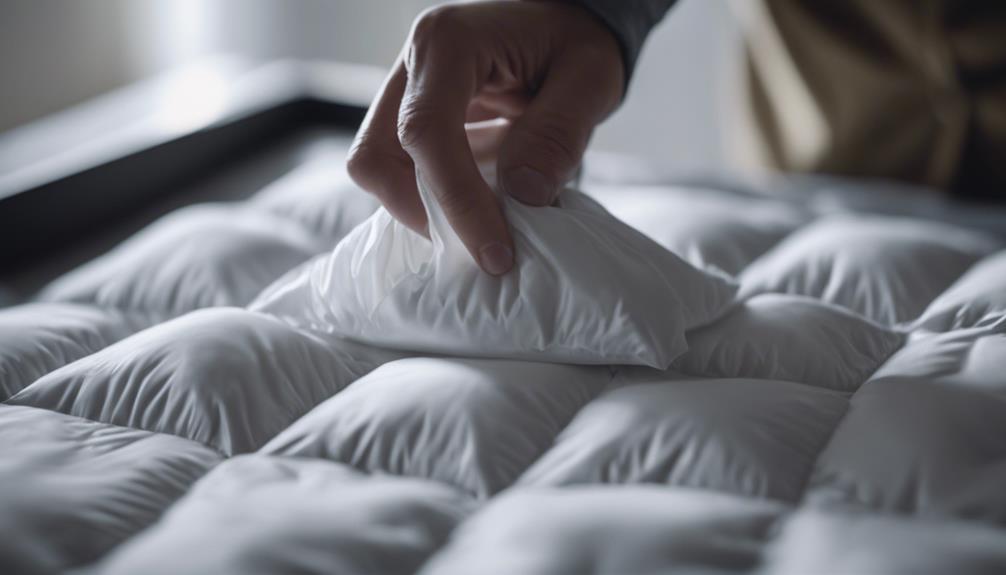Feathers may emerge from your down comforter as a result of substandard construction, poor-quality materials, and the fabric weave becoming loose over time. Washing your comforter can exacerbate this issue by causing clumping and breakage. Visible signs of wear such as loose threads or holes can also contribute to feathers escaping. Protective liners and a higher thread count can help keep feathers contained. Regularly fluffing your comforter by shaking it or using dryer balls can help maintain its loftiness. Preventative measures like featherproof fabric and duvet covers can also be effective. If your comforter does experience wear and tear, repair options include using zippered liners and starch solutions. By taking good care of your comforter – through regular cleaning, fluffing, and investing in a quality product – it can last for 10-15 years.
Key Takeaways
- Poor construction and low-quality materials contribute to feather leakage.
- Washing can lead to clumping and breakage of feathers.
- Fabric weave loosening allows feathers to escape.
- Use of protective liners like zippered covers can prevent feather leakage.
- Fluffing techniques help maintain loftiness and prevent feather matting.
Reasons for Feather Leakage
Feathers may escape from a down comforter due to factors such as poor construction, low-quality materials, or fabric weave loosening over time. When the thread count of the comforter is low, the feathers can easily work their way through the fabric. Additionally, using a duvet cover can help prevent feather leakage by providing an extra layer of protection for the comforter. It's important to make sure that the comforter needs are met, such as avoiding abrupt movements or excessive pressure that can cause feathers to come out.
Furthermore, if the comforter isn't properly maintained, such as infrequent washing or improper drying, this can contribute to feather leakage. Over time, the fabric weave of the comforter may loosen, allowing feathers to escape. Additionally, if feather quills start poking through the fabric, it can lead to feathers coming out of the down comforter. Proper care and attention to the comforter can help prevent feather leakage and ensure its longevity.
Impact of Washing on Feathers
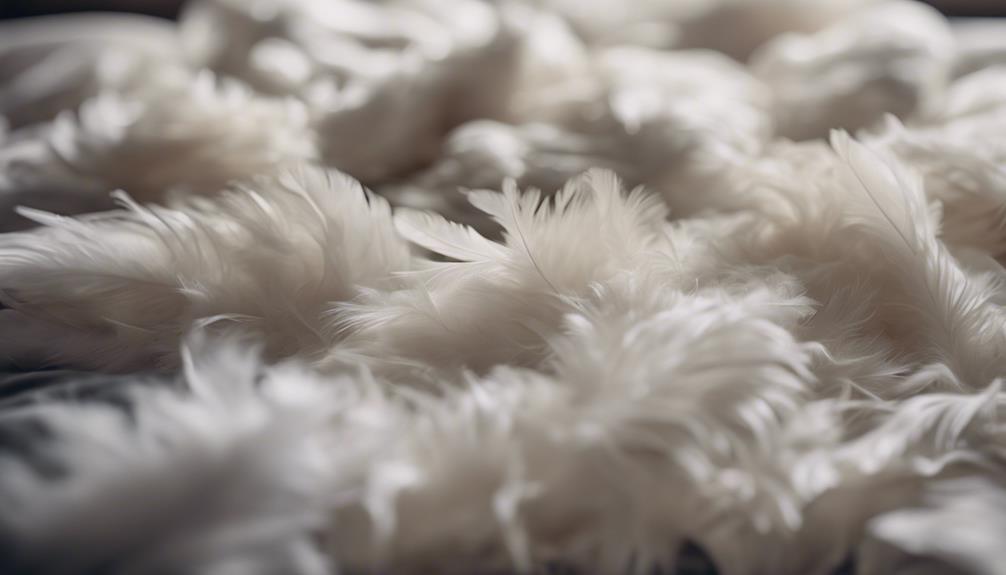
When washing down comforters, one must be careful of potential impacts on the feathers, including clumping, loss of fluffiness, and breakage caused by agitation during the process. These effects can be worsened by improper drying techniques like high heat settings. Using regular washing machines may not be suitable for down comforters, leading to feather leakage. Adhering to manufacturer guidelines for washing and drying is essential to prevent excessive feather loss.
| Potential Impacts on Feathers |
|---|
| Clumping |
| Loss of Fluffiness |
| Breakage from Agitation |
Signs of Wear and Tear
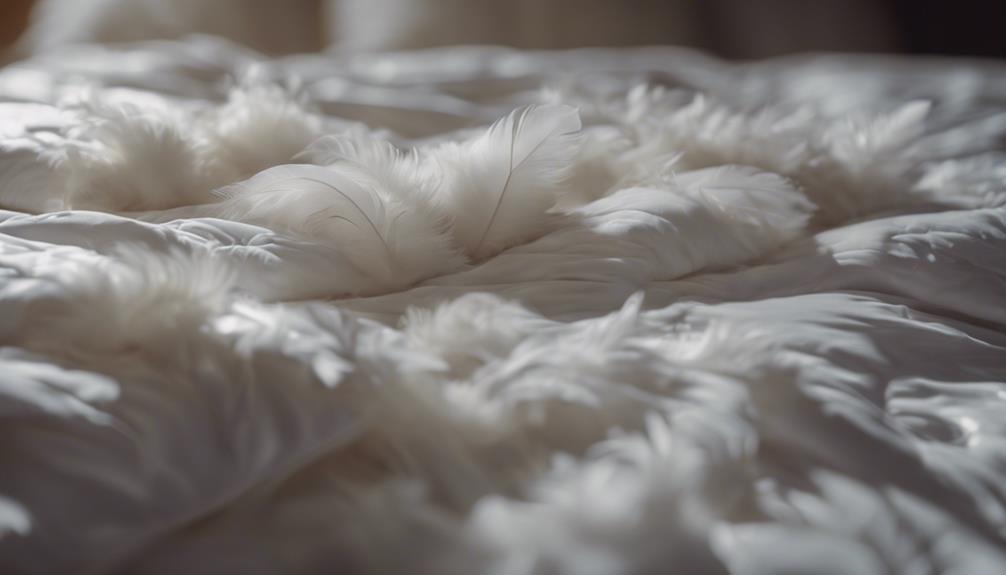
Examining down comforters regularly for signs of wear and tear is crucial in preventing feather leakage. Feathers coming out of a down comforter can indicate issues with the fabric or stitching. Loose threads, holes, or tears in the comforter's cover are common culprits allowing feathers to escape. Continuous use and washing can contribute to fabric breakdown, leading to feather leakage.
It's vital to inspect the comforter frequently for any damage to address feather loss promptly. If significant wear and tear is noticed, seeking repair or replacement can prevent further feather leakage. Remember, prevention is essential in maintaining the quality of your down comforter. Our tips can help you keep your comforter in top condition. These suggestions are valuable, especially if you want to avoid waking up covered in feathers.
Stay vigilant and proactive in caring for your down comforter to ensure long-lasting comfort and warmth. Remember, feather leakage is preventable with proper maintenance. Our top recommendations for care are designed to keep your comforter cozy and intact. Remember, feather leakage can be a thing of the past with these simple steps. Stay informed and proactive in maintaining your down comforter. These strategies will keep your bedding in prime condition for years to come.
Importance of Protective Liners
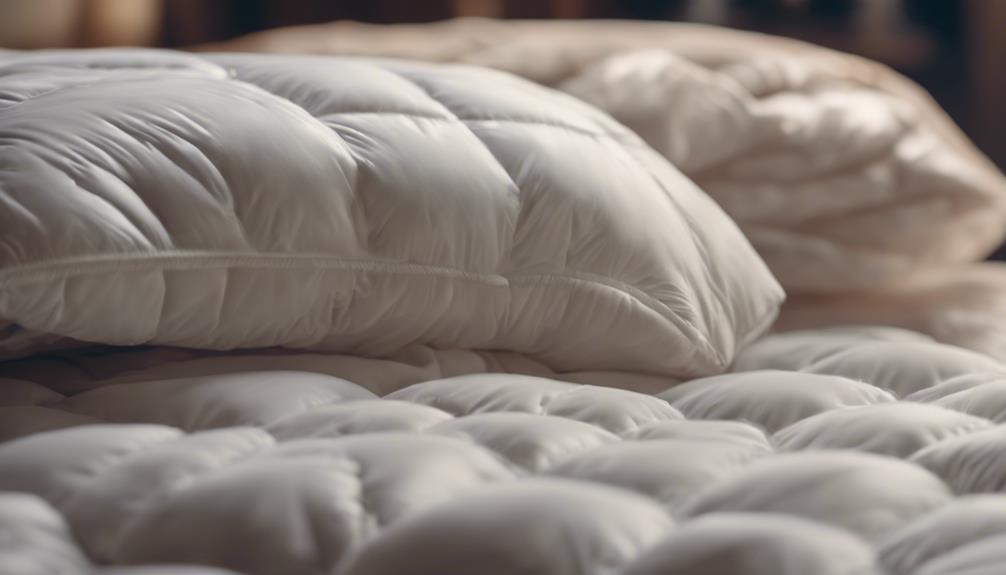
To enhance the longevity of your down comforter and minimize feather leakage, utilizing a protective liner is a practical solution. A zippered liner helps contain feathers and prevent them from escaping, maintaining the comforter's quality.
Fabrics with higher thread counts are effective in reducing feather leakage, as they provide a tighter barrier. It's recommended to clean covered comforters every 3-5 years to prevent feather loss and maintain their integrity.
Additionally, applying a starch solution can toughen the fibers of the comforter, further preventing feather leaks. By placing your comforter inside a protective liner, you add an extra layer of defense against feather leakage, ensuring a longer lifespan for your cozy bedding.
Fluffing Techniques for Down Comforters
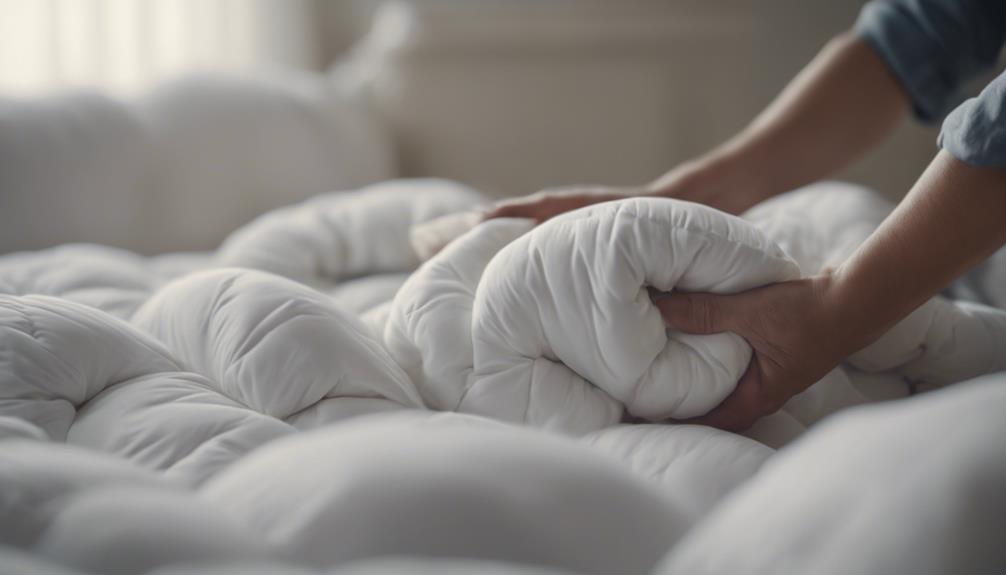
To maintain the loft and insulation of your down comforter, consider fluffing it with your hands, using dryer balls, or employing the gentle shaking method. These techniques help redistribute the feathers evenly, preventing clumping and matting for consistent warmth and comfort.
Remember that regular fluffing can prolong the overall quality and effectiveness of your down comforter.
Fluffing With Hands
Gently fluffing our down comforter with our hands is a simple yet effective way to maintain its loftiness and prevent clumping. By redistributing the feathers evenly, we can guarantee the comforter stays fluffy and comfortable.
Regular fluffing also helps aerate the down fill, keeping it fresh. It's important to use gentle motions and avoid vigorous shaking or beating, as this can damage the comforter.
Fluffing with hands is a quick and easy method to refresh the appearance and feel of our down comforter. With this simple technique, we can enjoy a cozy and well-maintained bedding experience.
Using Dryer Balls
After gently fluffing our down comforter with our hands, another effective method for maintaining its loftiness and preventing clumping is using dryer balls. These handy tools help redistribute the feathers inside the comforter evenly, ensuring consistent warmth.
By agitating the filling, dryer balls prevent matting and clumping, preserving the comforter's fluffiness over time. Additionally, they can speed up the drying process by enhancing air circulation, making it more efficient.
Not only are dryer balls eco-friendly, but they also serve as a natural alternative to dryer sheets, reducing static and softening the comforter without the need for harsh chemicals. Consider using dryer balls to keep your down comforter in top condition.
Gentle Shaking Method
Regularly shaking the down comforter aids in evenly redistributing the feathers, preventing clumping and maintaining loftiness. This gentle method helps to keep the feathers from matting together, ensuring that the comforter retains its fluffy and insulating properties.
It's important not to shake too vigorously, as this could damage the delicate down clusters. By fluffing the comforter regularly, you can improve its overall appearance and comfort level.
This simple technique can go a long way in ensuring that your down comforter remains in top condition, providing you with cozy warmth and a luxurious sleeping experience. So, remember to give your comforter a gentle shake every so often to keep it in prime condition.
Repairing Holes and Tears
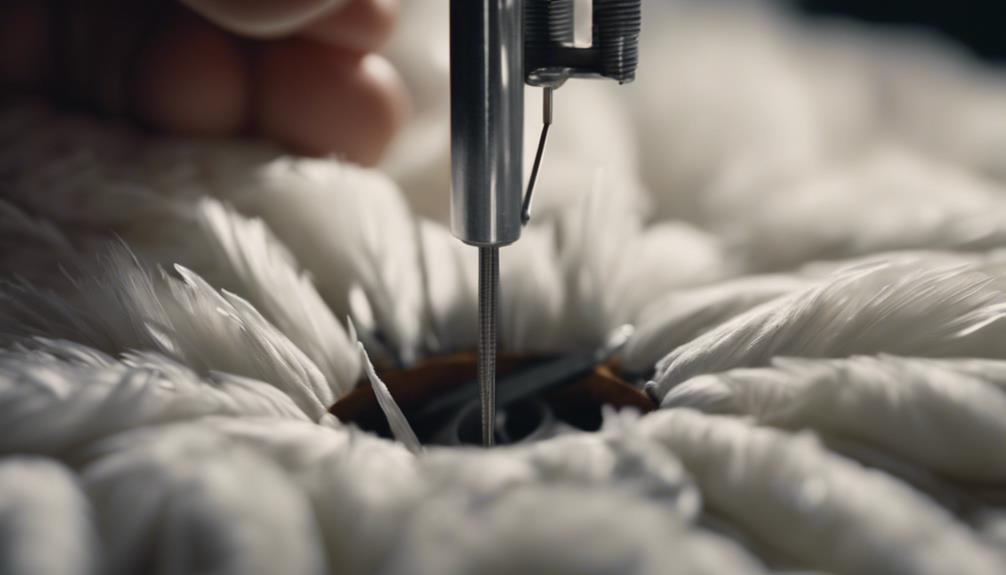
To effectively address holes and tears in a down comforter, timely repair is vital to prevent further feather loss. Small holes and tears should be fixed promptly using hand sewing techniques or iron-on patches to mend any damaged areas effectively.
It's important to fill baffled sections with appropriate replacement down to maintain the comforter's integrity. If there's significant feather fill loss, it's essential to address it immediately to prevent excessive leakage.
Properly repairing holes and tears in the comforter can prolong its lifespan and prevent ongoing feather loss. By taking these repair steps promptly and effectively, you can make sure that your down comforter remains in good condition and continues to provide warmth and comfort for a longer period.
Regularly checking for and repairing any damage will help maintain the quality of your comforter for years to come.
Thread Count and Feather Retention
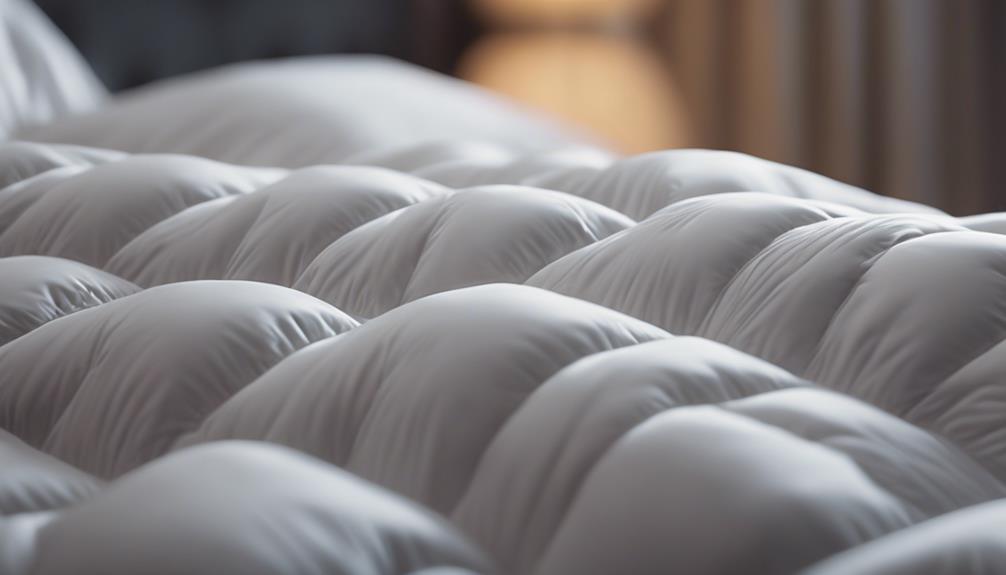
When considering the quality of a down comforter, the thread count of the fabric weave plays a significant role in retaining feathers within the bedding. Higher thread counts create a denser fabric that helps trap feathers inside the comforter.
Tight stitching in the comforter further reduces the likelihood of feathers escaping through the seams. Quality construction techniques, such as baffle box stitching, can also minimize feather loss.
However, it's crucial to understand that poor maintenance and washing techniques can contribute to feather leakage from the comforter. Regularly fluffing and airing out the comforter, following care instructions, and using a duvet cover can help maintain its integrity.
If a comforter exhibits abnormal feather leakage, it may be a sign of defects and might need to be replaced to ensure optimal comfort and longevity. By understanding how thread count and construction affect feather retention, you can make informed choices when selecting a down comforter.
Preventing Feather Escape
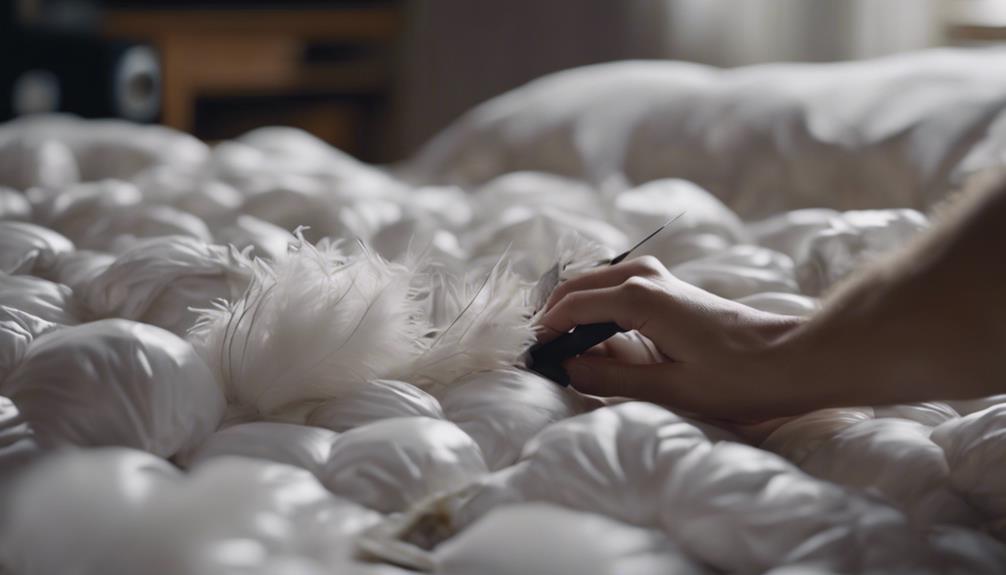
To prevent feathers from escaping your down comforter, consider using featherproof cotton twill fabric for its tight weaving.
Adding a duvet cover provides an extra layer of protection against feather leakage.
Regular maintenance, washing, and using a zippered liner can also help in containing the feathers within the comforter.
Feather Containment Methods
Using ticking or down-proof fabric for the inner lining effectively prevents feathers from escaping a down comforter. Placing the comforter inside a duvet cover adds an extra layer of protection against feather escape. Opting for featherproof cotton twill can effectively prevent feathers from poking through the fabric. Utilizing two pillowcases or a pair of high thread count sheets can serve as a temporary solution to contain feathers. Ensuring that the comforter is encased in a fabric specifically designed to contain feathers helps in preventing leakage.
| Feather Containment Methods | Description | Effectiveness |
|---|---|---|
| Ticking Fabric | Material for inner lining | Highly Effective |
| Duvet Cover | Additional protective layer | Effective |
| Featherproof Cotton Twill | Prevents feathers from poking out | Very Effective |
| Pillowcases/Sheets | Temporary containment solution | Temporary Fix |
| Specific Featherproof Fabric | Designed to contain feathers | Prevents Leakage |
Repairing Feather Leaks
After discussing methods for containing feathers in a down comforter, let's now address the process of repairing feather leaks to prevent feather escape.
To prevent feathers from coming out of your comforter, consider using a protective, zippered liner to contain them. Fabrics with higher thread counts are more effective in reducing feather escape. Maintaining covered comforters every 3-5 years is crucial to preserve quality and prevent feather loss.
Applying a starch solution can toughen the fibers of the comforter, decreasing the likelihood of leaks. Additionally, placing the comforter inside a liner adds an extra layer of protection against feather escape. These steps can help you rectify feather leaks and guarantee a comfortable and feather-free sleeping experience.
Longevity of Down Comforters
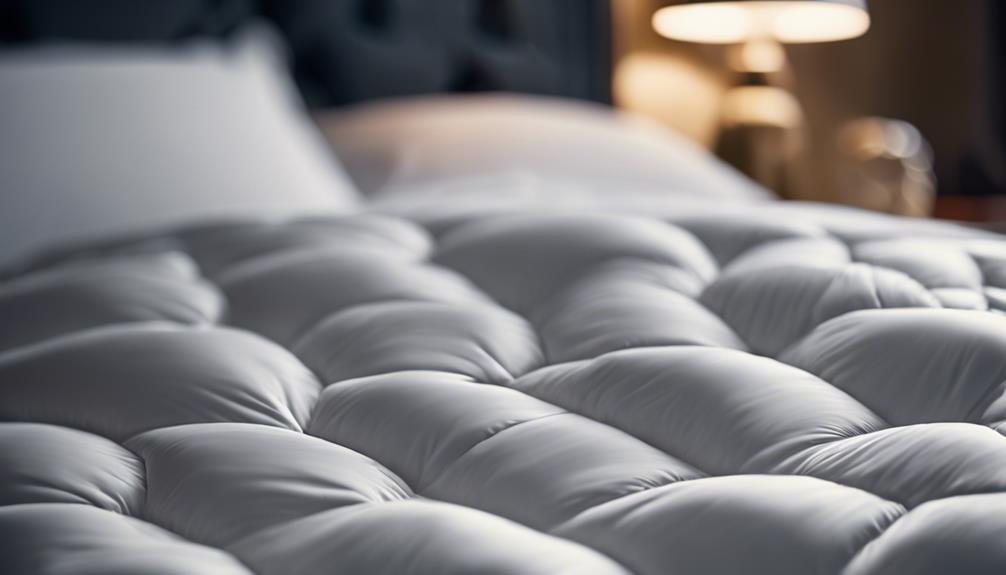
With proper care and maintenance, down comforters typically last between 10 to 15 years, depending on the quality of the material used. High-quality down comforters tend to have a longer lifespan compared to lower-quality ones. Regular cleaning and fluffing can help extend the longevity of a down comforter. Keep in mind that over time, the down clusters inside the comforter may break down, affecting its insulation properties. To preserve the comforter, investing in a duvet cover can protect it and contribute to its durability.
Taking these steps can guarantee that your down comforter remains in good condition for a decade or more. By following proper care instructions, such as washing and drying techniques recommended by the manufacturer, you can help maintain the loft and warmth of your comforter. Remember, a well-cared-for down comforter can provide you with cozy nights of rest for many years to come.
Frequently Asked Questions
How to Stop Feathers From Coming Out of a Down Comforter?
To prevent feathers from escaping a down comforter, use a duvet cover made of tightly woven fabric. Consider adding a protective liner with a high thread count.
Opt for featherproof materials to contain the feathers. Double up on pillowcases or high thread count sheets as a temporary measure.
Guarantee the comforter is properly encased in a fabric that traps and contains the feathers effectively.
Why Are Feathers Coming Out of My Blanket?
Feathers may escape from a down comforter due to wear, washing errors, or fabric quality issues. It's important to use a duvet cover to prevent this.
Opt for featherproof cotton twill or down-proof fabric for minimal leakage. Remember, proper maintenance and fabric choice are key in reducing feather loss.
Why Is My Comforter Shedding?
Ensuring gentle handling of the comforter and using protective covers to prevent feather leakage is crucial due to various factors like construction quality, usage, washing methods, and fabric integrity.
Improving these practices can help maintain the comforter's durability and reduce shedding. Regular maintenance and care are key to preserving the quality of your down comforter.
When Should You Throw Away a Down Comforter?
When it's time to toss your down comforter, signs like irreparable damage, excessive feather loss, flatness, lumps, or inadequate warmth are red flags.
Mold, mildew, and persistent odors despite cleaning signal it's time to let go.
Clumped or shifted filling making it uncomfortable means it's run its course.
If your comforter's best days are behind it, it might be best to part ways and find a new cozy companion.
Will Feathers Coming Out of My Down Comforter Cause it to Turn Yellow?
Feathers coming out of your down comforter can contribute to the yellowing of the fabric. The natural shedding of feathers can release oils that cause the fabric to discolor over time. Proper care such as regular washing and air drying can help prevent down comforter yellowing causes.
Conclusion
To sum up, feather leakage in down comforters is a common issue caused by wear and tear, washing, and low thread counts.
To prevent feathers from escaping, be sure to use protective liners, regularly fluff your comforter, and repair any holes or tears promptly.
By taking these steps, you can prolong the longevity of your down comforter and enjoy its warmth and comfort for years to come.
